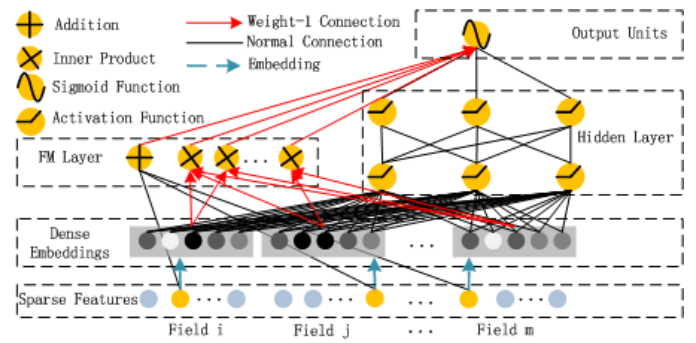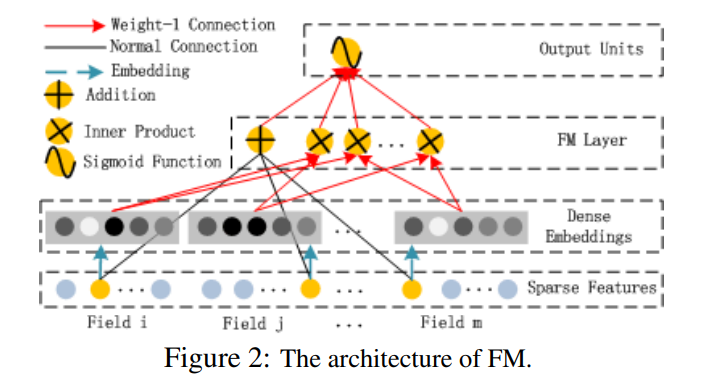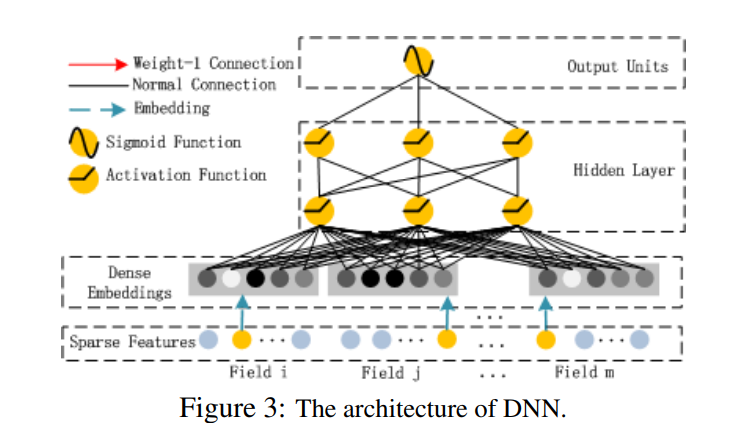-
Notifications
You must be signed in to change notification settings - Fork 851
add DeepFM knowledge #734
New issue
Have a question about this project? Sign up for a free GitHub account to open an issue and contact its maintainers and the community.
By clicking “Sign up for GitHub”, you agree to our terms of service and privacy statement. We’ll occasionally send you account related emails.
Already on GitHub? Sign in to your account
base: master
Are you sure you want to change the base?
add DeepFM knowledge #734
Changes from all commits
d8a7040
51a0d28
d82ae39
3bf764b
45586d6
3da5837
4b78bbd
2a6d4de
d972a60
8077d93
2c602b7
ad3e385
7fadb2d
7015a3c
50d7ec8
ef21ced
File filter
Filter by extension
Conversations
Jump to
Diff view
Diff view
There are no files selected for viewing
| Original file line number | Diff line number | Diff line change |
|---|---|---|
| @@ -0,0 +1,82 @@ | ||
| # DeepFM模型 | ||
|
|
||
| ## 1.模型简介 | ||
|
|
||
| CTR预估是目前推荐系统的核心技术,其目标是预估用户点击推荐内容的概率。DeepFM模型包含FM和DNN两部分,FM模型可以抽取low-order(低阶)特征,DNN可以抽取high-order(高阶)特征。低阶特征可以理解为线性的特征组合,高阶特征,可以理解为经过多次线性-非线性组合操作之后形成的特征,为高度抽象特征。无需Wide&Deep模型人工特征工程。由于输入仅为原始特征,而且FM和DNN共享输入向量特征,DeepFM模型训练速度很快。 | ||
|
|
||
| 注解:Wide&Deep是一种融合浅层(wide)模型和深层(deep)模型进行联合训练的框架,综合利用浅层模型的记忆能力和深层模型的泛化能力,实现单模型对推荐系统准确性和扩展性的兼顾。 | ||
|
|
||
| ## 2.DeepFM模型结构 | ||
|
|
||
| 为了同时利用low-order和high-order特征,DeepFM包含FM和DNN两部分,两部分共享输入特征。对于特征i,标量wi是其1阶特征的权重,该特征和其他特征的交互影响用隐向量Vi来表示。Vi输入到FM模型获得特征的2阶表示,输入到DNN模型得到high-order高阶特征。 | ||
|
There was a problem hiding this comment. Choose a reason for hiding this commentThe reason will be displayed to describe this comment to others. Learn more. low-order和highe-order解释一下是啥 |
||
|
|
||
|
|
||
| $$ | ||
| \hat{y} = sigmoid(y_{FM} + y_{DNN}) | ||
| $$ | ||
|
|
||
| DeepFM模型结构如下图所示,完成对稀疏特征的嵌入后,由FM层和DNN层共享输入向量,经前向反馈后输出。 | ||
|
|
||
|  | ||
|
|
||
| ## 3.FM | ||
|
|
||
| FM(Factorization Machines,因子分解机)最早由Steffen Rendle于2010年在ICDM上提出,它是一种通用的预测方法,在即使数据非常稀疏的情况下,依然能估计出可靠的参数进行预测。与传统的简单线性模型不同的是,因子分解机考虑了特征间的交叉,对所有嵌套变量交互进行建模(类似于SVM中的核函数),因此在推荐系统和计算广告领域关注的点击率CTR(click-through rate)和转化率CVR(conversion rate)两项指标上有着良好的表现。 | ||
|
|
||
| FM模型不单可以建模1阶特征,还可以通过隐向量点积的方法高效的获得2阶特征表示,即使交叉特征在数据集中非常稀疏甚至是从来没出现过。这也是FM的优势所在。 | ||
|
There was a problem hiding this comment. Choose a reason for hiding this commentThe reason will be displayed to describe this comment to others. Learn more. FM介绍再详细一点,目前就只有一个公式,借鉴一下这个,给一个这一样的应用示例:https://www.biaodianfu.com/ctr-fm-ffm-deepfm.html |
||
|
|
||
|
|
||
| $$ | ||
| y_{FM}= <w,x> + \sum_{j_1=1}^{d}\sum_{j_2=j_1+1}^{d}<V_i,V_j>x_{j_1}\cdot x_{j_2} | ||
|
There was a problem hiding this comment. Choose a reason for hiding this commentThe reason will be displayed to describe this comment to others. Learn more. 介绍的比较简单,FM的原理希望通俗易懂,我查了一下资料,可以参考: |
||
| $$ | ||
|
|
||
| 单独的FM层结构如下图所示: | ||
|
|
||
|  | ||
|
There was a problem hiding this comment. Choose a reason for hiding this commentThe reason will be displayed to describe this comment to others. Learn more. 目前FM的部分描述比较简单,考虑补充FM的学习过程,FM的优缺点等等 |
||
|
|
||
| ## 4.DNN | ||
|
|
||
|
There was a problem hiding this comment. Choose a reason for hiding this commentThe reason will be displayed to describe this comment to others. Learn more. wide&Deep详细说一下,不一定每个人都知道 There was a problem hiding this comment. Choose a reason for hiding this commentThe reason will be displayed to describe this comment to others. Learn more. 考虑回答一下,为什么选择DNN要跟FM结合,RNN跟FM能够结合吗?分析一下DNN+FM结合的好处 |
||
| 该部分和Wide&Deep模型类似,是简单的前馈网络。在输入特征部分,由于原始特征向量多是高纬度,高度稀疏,连续和类别混合的分域特征,因此将原始的稀疏表示特征映射为稠密的特征向量。 | ||
|
|
||
| 假设子网络的输出层为: | ||
|
|
||
|
|
||
| $$ | ||
| a^{(0)}=[e1,e2,e3,...en] | ||
| $$ | ||
| DNN网络第l层表示为: | ||
|
|
||
|
|
||
| $$ | ||
| a^{(l+1)}=\sigma{(W^{(l)}a^{(l)}+b^{(l)})} | ||
| $$ | ||
| 再假设有H个隐藏层,DNN部分的预测输出可表示为: | ||
|
|
||
|
|
||
| $$ | ||
| y_{DNN}= \sigma{(W^{|H|+1}\cdot a^H + b^{|H|+1})} | ||
| $$ | ||
| DNN深度神经网络层结构如下图所示: | ||
|
|
||
|  | ||
|
|
||
| ## 5.Loss及Auc计算 | ||
|
|
||
| DeepFM模型的损失函数选择Binary_Cross_Entropy(二值交叉熵)函数 | ||
|
|
||
|
|
||
|
There was a problem hiding this comment. Choose a reason for hiding this commentThe reason will be displayed to describe this comment to others. Learn more. |
||
| $$ | ||
| H_p(q)=-\frac{1}{N}\sum_{i=1}^Ny_i\cdot log(p(y_i))+(1-y_i) \cdot log(1-p(y_i)) | ||
| $$ | ||
|
There was a problem hiding this comment. Choose a reason for hiding this commentThe reason will be displayed to describe this comment to others. Learn more. 添加的公式的每一个字符都需要解释 |
||
| 对于公式的理解,y是样本点,p(y)是该样本为正样本的概率,log(p(y))可理解为对数概率。 | ||
|
|
||
| Auc是Area Under Curve的首字母缩写,这里的Curve指的就是ROC曲线,AUC就是ROC曲线下面的面积,作为模型评价指标,他可以用来评价二分类模型。其中,ROC曲线全称为受试者工作特征曲线 (receiver operating characteristic curve),它是根据一系列不同的二分类方式(分界值或决定阈),以真阳性率(敏感性)为纵坐标,假阳性率(1-特异性)为横坐标绘制的曲线。 | ||
|
|
||
|
There was a problem hiding this comment. Choose a reason for hiding this commentThe reason will be displayed to describe this comment to others. Learn more. 在这里加一节DeepFM和其他模型的比较,比如目前在推荐领域中比较流行的深度模型FNN、PNN、Wide&Deep等 |
||
| 可使用paddle.metric.Auc()进行调用。 | ||
|
|
||
| ## 6.参考文献 | ||
|
|
||
| [[IJCAI 2017]Guo, Huifeng,Tang, Ruiming,Ye, Yunming,Li, Zhenguo,He, Xiuqiang. DeepFM: A Factorization-Machine based Neural Network for CTR Prediction](https://arxiv.org/pdf/1703.04247.pdf) | ||
|
|
||
|
|
||
|
|
||
There was a problem hiding this comment.
Choose a reason for hiding this comment
The reason will be displayed to describe this comment to others. Learn more.
低阶特征和高阶特征,描述的比较简单,能够举个例子吗?